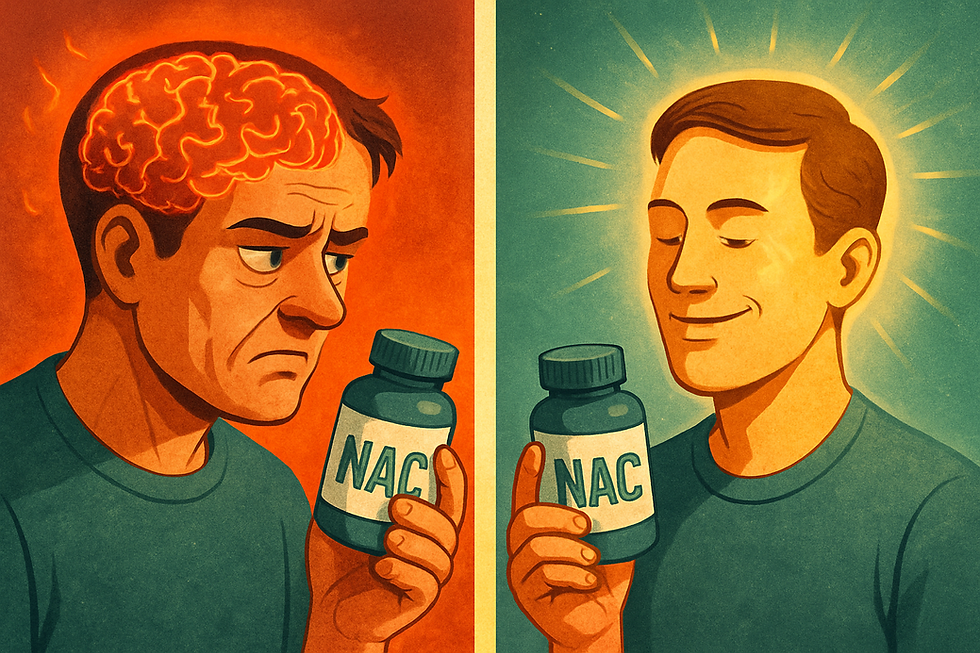N-Acetylcysteine (NAC): Your Brain’s Unsung Antioxidant Sidekick
- ryanshortpmhnp
- Aug 10
- 3 min read
Updated: Aug 18

Imagine your brain as a bustling city. Every cell is a building, every chemical messenger a text message. NAC is like a behind-the-scenes fixer—clearing away toxic roadblocks and helping messages get through more smoothly.
Mechanism of Action—What NAC Actually Does
NAC is a derivative of the amino acid cysteine. Your body converts it into glutathione—one of the body’s most powerful antioxidants. Glutathione protects your cells from oxidative stress, which is a type of damage caused by unstable molecules called free radicals.
Glutathione also helps regulate the brain’s glutamate and dopamine systems. These neurotransmitters play key roles in mood, focus, and motivation. NAC appears to influence the receptors and transporters that control their levels, leading to more stable brain chemistry.
By reducing inflammation and oxidative stress, NAC may improve mitochondrial function (the “power plants” of your cells), encourage neural plasticity (your brain’s ability to adapt and form new connections), and increase production of brain-derived neurotrophic factor (BDNF), a protein that supports neuron health.
What Mental Health Areas Might Benefit
Obsessive-compulsive and body-focused behaviors
NAC has the strongest evidence for disorders like obsessive-compulsive disorder (OCD), trichotillomania (hair-pulling), nail-biting, and skin-picking. Benefits are most often seen when NAC is added to existing treatment.
Depression and bipolar disorder
Some studies suggest NAC can help reduce depressive symptoms by boosting glutathione levels, reducing inflammation, and balancing glutamate. Evidence for bipolar depression is mixed and generally lower in quality.
Schizophrenia
NAC may be helpful for “negative” symptoms such as lack of motivation and social withdrawal, especially when used alongside standard medications. This effect is likely related to its role in stabilizing glutamate.
Addictions and substance cravings
Results are inconsistent, but NAC has shown some promise in reducing cravings for tobacco, cocaine, and cannabis.
Other possibilities
Preliminary research is exploring NAC’s use in PTSD, autism, Alzheimer’s disease, and general mood or anxiety disorders. Current evidence is still too limited to draw strong conclusions.
Typical Dosing and Tolerability
For mental health purposes, research often uses doses between 1,200 mg and 3,600 mg per day, divided into two or three doses. Many clinicians recommend starting lower and increasing slowly to minimize side effects. The 1,800–2,400 mg daily range is common in studies.
Most people tolerate NAC well, but it is not without risks.
Side Effects—What to Watch For
Gastrointestinal symptoms: Upset stomach, nausea, vomiting, and diarrhea are the most frequent complaints.
Skin and allergic reactions: Rash, itching, and rare allergic reactions (including wheezing or swelling) have been reported, especially with inhaled or intravenous NAC.
Other possible effects: Fatigue, headaches, and eye irritation. NAC may slow blood clotting and can interact with certain medications, including immunosuppressants, nitrates, some antifungals, and specific antibiotics.
High doses: At doses far above those used in humans, animal studies suggest potential heart and lung issues. This is not typically a concern at standard supplemental levels, but it’s a reminder that more is not always better.
Putting It All Together—Practical Perspective
NAC is like a meticulous backstage crew member—not flashy, but able to improve the overall performance. It supports antioxidant defenses, calms inflammation, and helps regulate brain chemistry in ways that may benefit OCD, addictions, depression, and schizophrenia.
It should not replace standard care, and its effects are more reliable as an add-on rather than a standalone treatment. Given possible gastrointestinal side effects and interactions, talk to a healthcare provider before starting, especially if you plan to take 1,800–2,400 mg daily or are on other medications.
References
Dean, O., Giorlando, F., & Berk, M. (2011). N-acetylcysteine in psychiatry: Current therapeutic evidence and potential mechanisms of action. Journal of Psychiatry & Neuroscience, 36(2), 78–86. https://doi.org/10.1503/jpn.100057
Slattery, J., Kumar, N., & Delhey, L. (2015). Clinical trials of N-acetylcysteine in psychiatry and neurology: A systematic review. Neuroscience & Biobehavioral Reviews, 55, 294–321. https://doi.org/10.1016/j.neubiorev.2015.04.015
Tardiolo, G., Bramanti, P., & Mazzon, E. (2018). Overview on the effects of N-acetylcysteine in neurodegenerative diseases. Molecules, 23(12), 3305. https://doi.org/10.3390/molecules23123305
Bradlow, R. C. J., Berk, M., & Dean, O. M. (2022). The potential of N-acetyl-L-cysteine (NAC) in severe autism, schizophrenia, depression, and obsessive-compulsive and related disorders. CNS Drugs, 36(4), 361–379. https://doi.org/10.1007/s40263-022-00907-3
WebMD. (2025). N-acetylcysteine (NAC): Health benefits, side effects, dosage. Retrieved August 11, 2025, from https://www.webmd.com/diet/health-benefits-nac




Comments